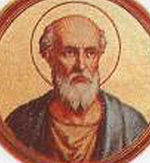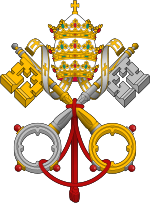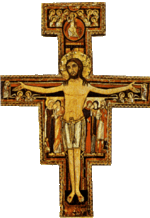Pope Evaristus
| Saint Evaristus | |
|---|---|
 |
|
| Papacy began | c. 99 |
| Papacy ended | c. 107 |
| Predecessor | Clement I |
| Successor | Alexander I |
| Personal details | |
| Birth name | Evaristus or Aristus |
| Born | 1st century AD Bethlehem, Palestine |
| Died | c. 107 Rome, Roman Empire |
| Papal styles of Pope Evaristus |
|
|---|---|
 |
|
| Reference style | His Holiness |
| Spoken style | Your Holiness |
| Religious style | Holy Father |
| Posthumous style | Saint |
Pope Saint Evaristus is accounted the fifth pope, holding office from c. 99 to 107 AD[1] or from 99 to 108.[2] He was also known as Aristus.
Little is known about St Evaristus. According to the Liber Pontificalis, he came from a family of Hellenic Jewish origin. He was elected during the reign of the Roman Emperor Domitian, the time of the second general persecution.
Eusebius, in his Ecclesiastical History IV, I, stated that Evaristus died in the 12th year of the reign of the Roman Emperor Trajan, after holding the office of bishop of the Romans for eight years.
It was once supposed that all the early Popes were martyrs. There is no confirmation of this in the case of Pope Evaristus, who is listed without that title in the Roman Martyrology, with a feast day on October 26.[3]
St Evaristus succeeded St Clement in the See of Rome during the reign of Trajan and governed the Church for about eight years, as the fourth successor of St. Peter. The Liber Pontificalis says that he was the son of a Hellenic Jew of Bethlehem, and, certainly incorrectly, that he divided Rome into several "titles" or Parishes, assigning a priest to each, and appointed seven deacons for the city. He is usually accorded the title of martyr, but his martyrdom is not proven. It is probable that St Evaristus was buried near St Peter's tomb in the Vatican. His feast day is celebrated on October 26.[4]
References
- ↑ "Pope St. Evaristus". Catholic Encyclopedia. New York: Robert Appleton Company. 1913. http://www.newadvent.org/cathen/05646a.htm.
- ↑ "Annuario Pontificio"
- ↑ "Martyrologium Romanum" (Libreria Editrice Vaticana 2001 ISBN 88-209-7210-7)
- ↑ Catholic Online - Saints & Angels: "St. Evaristus"
External links
- Writings attributed to Pope St Evaristus
- Patron Saints Index: Pope Saint Evaristus
- Catholic Online – Saints & Angels: St. Evaristus
 Chisholm, Hugh, ed (1911). "Evaristus". Encyclopædia Britannica (Eleventh ed.). Cambridge University Press.
Chisholm, Hugh, ed (1911). "Evaristus". Encyclopædia Britannica (Eleventh ed.). Cambridge University Press.
| Catholic Church titles | ||
|---|---|---|
| Preceded by Clement I |
Bishop of Rome Pope 98–105 |
Succeeded by Alexander I |
|
|||||||||||||||||||||||||||||||||||||||||||||
|
|||||||||||||||||||||||||||||||||||||||||

